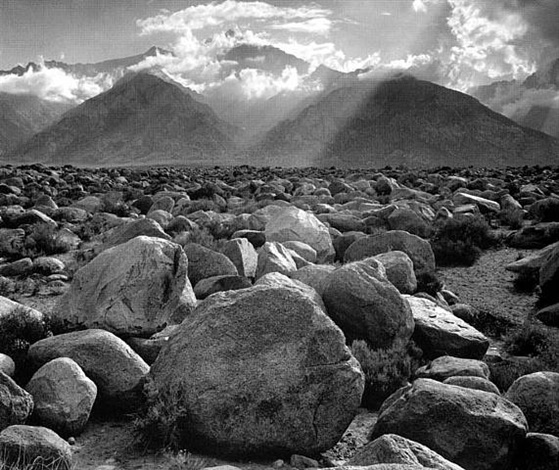
Ansel Adams
American (1902–1984)
Robert Mann Gallery
Landscape photographer and environmental activist Ansel Adams’s lucid black and white photographs of the American wilderness helped establish photography as a legitimate art form. A half-century later, there is still an unimpeachable interest in his work at virtually any price point.
“Ansel’s work seems to be sort of a ‘gold standard’ in the photography market,” the artist’s grandson Matthew Adams, president of the Ansel Adams Gallery, told artnet via email. “His work has appreciated, and does fluctuate with the market in general, but doesn’t see the extreme highs and lows that we sometimes see with other photographers’ work.”
Adams’s estate might not see the hysterical fluctuations of other photographers’ markets, but that’s not to say his work isn’t steadily appreciating. “The values have been steadily increasing over the years as the supply in the secondary market diminishes and the demand for his work increases,” said Robert Mann, a key player in Adams’s secondary market since the 1970s. “Virtually every institutional art collection and many private collections that include photography begin with Adams,” he told artnet via email, “so it is inevitable that the prints will become more scare and ultimately more valuable.”
To date, Adams’s auction record remains the sale of Clearing Winter Storm, Yosemite National Park (1938) at Sotheby’s 2010 Photographs from the Polaroid Collection sale, which featured 1,200 works from the defunct camera company’s cooperate collection. “Some of the high prices immediately after the financial meltdown in 2008 came at the sale of the Polaroid collection, a combination of provenance, big images, and big murals,” Adams explained. “We are seeing a return of the pricing from 2006–8, I think due more to inflation or expectations of inflation.” In April of this year, a mural-sized print of Winter Sunrise, Sierra Nevada from Lone Pine, California from 1961 sold at Christie’s New York above the $500,000 presale high estimate, for $545,000, including a buyer’s premium.
While rare mural-sized photographs command prices upwards of half a million-dollars, collectors at the lower end of the market can pick up signed prints for under $5,000. Adams’s most famous image, Moonrise, Hernandez, New Mexico (1941), ranges dramatically in price depending on size, condition, and vintage. A 1948 print of Moonrise in perfect condition sold at Sotheby’s in 2006 for $609,600. A “1970s print of the same size and condition,” Adams explains, “generally sells for about $50,000.” Another factor that is increasingly important in determining value is quality, which, Mann explained, refers not only to “physical condition,” but to “subtle variations in tonality and contrast.” Unlike auction houses, which typically assign estimates based on the past performances of particular images, experienced galleries and dealers take a rigorously connoisseurial approach to Adams’s work. “As the value for Adams’s prints continues to escalate,” said Mann, “this standard for pricing becomes more critical.”
For more art market analysis, please visit artnet Analytics.